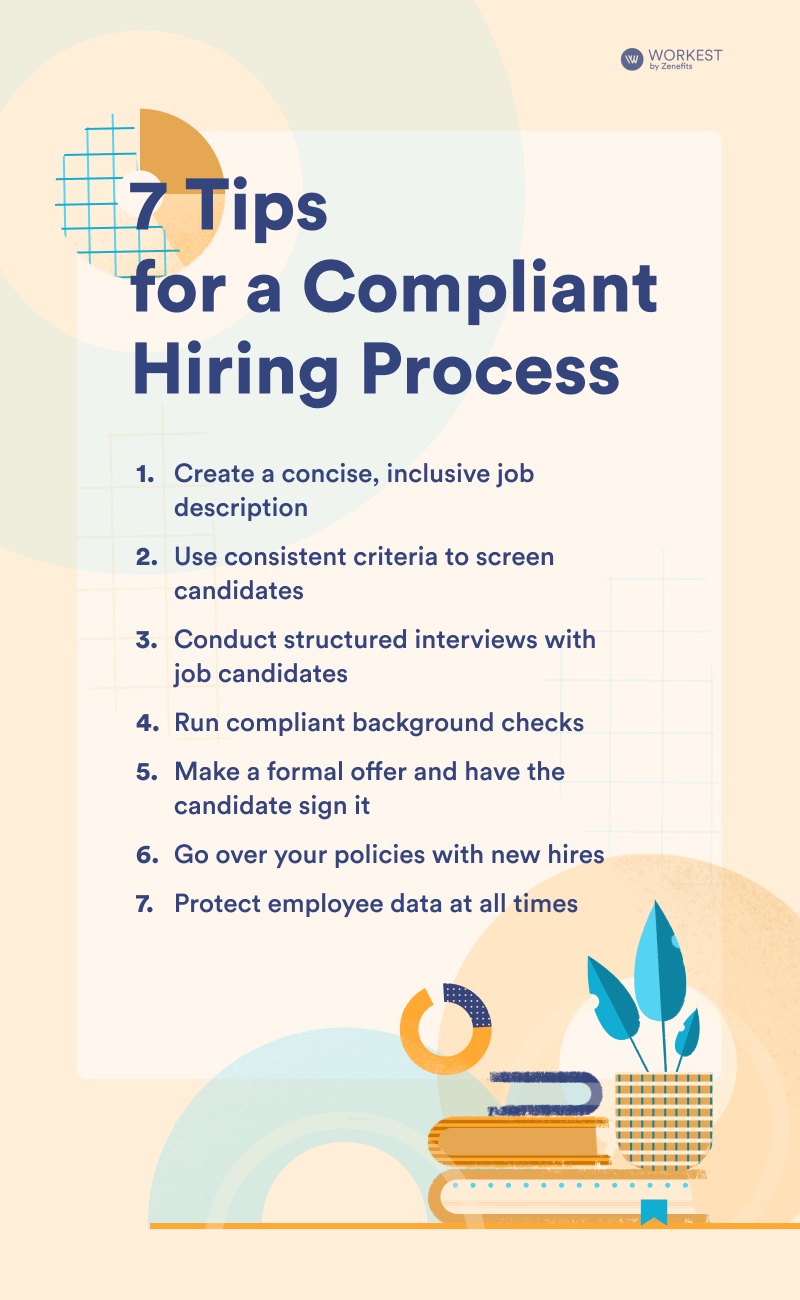Hiring is a necessity for any growing business. As a company expands, so does its need for new personnel. However, getting new team members on board can be challenging. On one hand, you want to move quickly to bring in the right talent. But on the other hand, you have to be careful not to violate your internal policies, industry practices, and employment regulations. Having a checklist for the hiring process is an excellent way to strike a balance between speed and compliance. By following a set of tried-and-true steps, you can be confident that you are not cutting corners and still get the job done efficiently. Let's dive deeper into the importance of compliance in hiring and review a checklist that you can use to guarantee an efficient legal process.
Why does compliance matter in recruitment?
Compliance is a significant consideration at each stage of the hiring process, from the initial job posting to extending an offer and even
employee onboarding. Several components fall under the hiring compliance umbrella, including:
- Anti-discrimination laws
- Minimum wage laws
- Background check guidelines
- I-9 requirements
- Scoring and weighting policies
- Data and integration security
- Privacy laws
Slip-ups in any of these areas can have dire consequences for your business. Below are some of the potential consequences of non-compliance:
- Hefty fines. Depending on the severity of the offense, your business could be subject to costly fines and penalties.
- A lawsuit from an applicant or employee for compliance issues like discriminatory hiring or unfair wages can cost your company time, money, and reputation.
- Missed opportunities. A bad hiring experience can dissuade talented candidates from joining your team. You may also struggle to attract meaningful business partners.
Therefore, it goes without saying that developing a compliance-focused recruiting strategy is in your best interest.

Manage your hiring process with a comprehensive compliance checklist
Given today's increasingly long list of compliance considerations, it is possible to overlook some essential elements when hiring new employees. Unfortunately, even small mistakes can have significant consequences for your business. To help you avoid potential compliance pitfalls, we have put together a handy checklist that covers all the bases. Use this list as a guide when conducting your next recruitment drive:
1. Create a concise, inclusive job description
Think of a job description as a marketing tool. It must give potential candidates a good idea of the role clearly and concisely. Beyond that, your job description must also comply with anti-discrimination laws. This means avoiding any language construed as biased against a protected class, such as age, race, or religion. Consider the tips below when creating a job description that is both informative and compliant:
- Use gender-neutral language. Pronouns like "he" or "she" can inadvertently exclude some groups of applicants.
- Focus on qualifications, not personal characteristics. For example, rather than saying "looking for a go-getter," try "must be able to work independently."
- Be specific about the duties of the role. This will help applicants understand what the job entails and whether they are a good fit.
- Include equal opportunity statements. Use statements that reaffirm your commitment to an equal-opportunity workplace. This could be something like, "we are an equal opportunity employer and do not discriminate based on race, color, religion, sex, sexual orientation, gender identity, national origin, disability, age, or veteran status."
- Be realistic. Avoid making promises you cannot keep, such as saying the position offers "amazing growth potential." While it's OK to be aspirational in a job description, you do not want to make false claims that could come back to bite you later.
2. Use consistent criteria to screen candidates
Once you start receiving applications, actively review each one and compare it against the job posting to see if the candidate meets the minimum qualifications for the role. If they do not, feel free to reject their application outright. If a candidate does meet the basic criteria, take a closer look at their resume and cover letter to get a sense of their work experience and skills. Then, identify a shortlist of the most qualified candidates and invite them to an interview.
The goal is to create a level playing field for all candidates so that you can make the best hiring decision for your company.
Throughout this screening process, it is essential to use consistent criteria to evaluate each candidate. This means avoiding any personal biases you might have about a particular applicant. For example, do not let your prejudices about someone's age, race, or gender influence your decision about whether or not to interview them. The goal is to create a level playing field for all candidates so that you can make the best hiring decision for your company.
3. Conduct structured interviews with job candidates
This is usually the most time-consuming part of the hiring process, but it is also the most important. According to a
CareerBuilder study, 20% of hiring managers have asked a question in a job interview only to find out later that it was illegal to ask. Planning and structuring your interviews in advance is the best way to avoid legal trouble. Develop a list of questions appropriate for the role you are hiring for, and stay away from anything that could come across as discriminatory. The
Equal Employment Opportunity Act (EEOA) outlaws asking questions that might result in discrimination or give off the impression of bias. In a nutshell, you are not permitted to ask any questions that have anything to do with a candidate's:
- Age
- Country of origin
- Religion
- Sexual orientation and gender identity
- Disability status
- Marital or family status
- Pregnancy
Also, avoid questions about a candidate's plans for the future. For example, do not ask them if they plan on having children soon or if they are considering going back to school. The point is, when in doubt, do not ask the question. If you are unsure whether a particular line of questioning is appropriate, consult a lawyer before moving forward. After you have gathered all the information you need from the interview, it is time to decide. Reference the job posting, compare the candidate's qualifications to what you're looking for, and choose the best person for the role.
4. Run compliant background checks
Background checks are essential to the hiring process but can also be a minefield of legal compliance issues. You can run several background checks on your candidates, including credit checks, criminal history checks, employment verification, and education verification. However, each comes with a set of rules and regulations you need to follow. For example, the
Fair Credit Reporting Act (FCRA) stipulates that you must obtain written permission from a candidate before running a credit check. However, even after getting the OK, you can only use the credit report to make hiring decisions if they are "job-related and consistent with business necessity." The best way to avoid legal issues with background checks is to partner with a reputable company. They will be up-to-date on all the latest compliance regulations and can help you navigate the process smoothly.
5. Make a formal offer and have the candidate sign it
Once you have decided on a candidate, it is time to make a job offer. Be sure to extend the offer over the phone, so you can explain the details of the position and answer any questions the candidate might have. It is an excellent opportunity to make the candidate feel valued. After you have made the offer, send a follow-up email or letter that outlines the important points of the job offer, including:
- Job title
- Compensation
- Benefits
- Start date
- Location
Your offer letter must also include a statement that says the offer is contingent on the background check results. This will protect you in case anything comes up during the process that changes your mind about hiring the candidate. Have the candidate send a signed copy of the offer letter as written confirmation they accepted the terms.
6. Go over your policies with new hires
The final step is to welcome your new employee and officially get them onboarded into the company. Depending on your company's policies, this process might involve a training program, orientation, or paperwork. Some of the things you will need to go over with your new hire include the following:
- The company's policies and procedures
- Benefits and compensation
- Paid time off (PTO) policy
- Company culture
- Their roles and responsibilities within the company
- The expectations for their performance
It is also a good idea to tour the office and introduce them to their coworkers. Making your new employee feel comfortable and welcome from day one will help them hit the ground running and become a productive team member.
7. Protect employee data at all times
Data privacy is a hot-button issue these days, and rightfully so. With all the sensitive information you will be collecting from your new employees, it is essential to have procedures in place to keep it safe. After all, a data breach can be costly for your business, not to mention the damage it can do to your reputation. Here are some steps to protect employee data during and after the hiring process.
- Encrypt all sensitive data, both in transit and at rest.
- Use strong passwords and multi-factor authentication for all systems.
- Restrict access to sensitive data to only those who need it.
- Regularly back up all employee data.
- Securely destroy all outdated employee data.
Taking these precautions can help ensure that your employee data stays safe and avoid costly litigation down the road.
Ensure business continuity with a compliant hiring process
Hiring has evolved dramatically over the years. With the rise of the gig economy, remote hiring, and virtual interviews, the process has become more complex than ever. However, one thing remains the same: the importance of compliance. HR professionals must have substantial expertise in recruiting compliance to protect their organizations from legal risks. A checklist can be a helpful tool to ensure you check all the compliance boxes. To summarize, here are the key steps to a compliant hiring process:
- Create a concise and inclusive job description
- Use consistent criteria to screen candidates
- Conduct structured interviews with job candidates
- Run compliant background checks
- Make a formal offer and have the candidate sign it
- Go over your policies with new hires
- Protect employee data at all times
By adhering to the checklist above, you can avoid legal issues during your hiring process and create a safe and compliant environment for your new employees.



